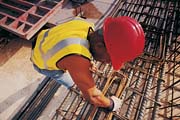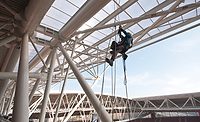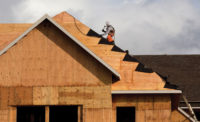
Anatomy of Fall Dynamics
Most accidental falls are precipitated by some causal event that may create movement forces that compound as the victim generates a 5,000-pound impact mass after 6-foot free-fall. The ANSI design specifications of the deceleration device limit the resulting terminal impact to 1,800 pounds maximum. The heavier the victim (310 pounds ANSI weight limit), of course, the greater the force of impact. The spinal orientation of the victim (relative to his lanyard vector) at the moment that terminal forces are applied will contribute significantly to the resulting trauma to the body.Any asymmetrical applications of force to the harness, partially dissipated by the deceleration device, is terminally applied to the pelvic region. While impact forces are dissipated by all of the harness straps, they are rarely uniformly applied. The lower extremities ultimately receive a dominant percentage of the load. As the "slamming effect" at termination is delivered by the lanyard to the contact areas of the body, the nylon fibers begin to stretch around the upper legs, groin and buttocks. The harness straps reach maximum elongation and then quickly begin to contract against the soft tissues of the thighs, creating a tourniquet effect to both the legs and lower abdominal muscles.
Often, if the fall occurs in a vertical vector, the impact may thrust the gastrointestinal system violently up against the diaphragm, causing the victim to temporarily loose his breath, perhaps damaging the protective pleural membrane around the heart and lungs. The initial breath is often lost due to rapid deceleration impact (or slam). As subsequent breaths may be lost with each rebound, breathing becomes more difficult due to the clinching effect of the chest and waist straps on the upper body. Trauma from striking against fixed objects during the initial fall or the recovery rebound may add to the injuries and complicate the victim's post-fall physiology. Additional injuries, such as broken bones or ruptured spleen, may cause a serious, internal hemorrhage. External lacerations received by contact could also contribute significantly to blood volume loss. Once the fall victim has come to rest and survived the initial effects of his fall, his troubles have just begun.
The Faint Cycle
We have all seen the effects of stressed military personnel or wedding members who faint when they are required to stand motionless for prolonged periods of time. In a simple "vasovagal" faint, the victim's blood pools in his lower extremities by the force of gravity and, without muscular contractions, eventually reduces the blood volume to the heart and downstream organs. Sensing potential damage, the brain quickly shuts down the autonomic nervous system and the victim becomes temporarily unconscious, relaxing legs-first into a faint. By falling to a horizontal position, the blood easily returns to equilibrium in the cardiovascular system. Adequate blood flow returns to the brain and within minutes the victim regains consciousness.The PFAS-suspended victims, however, are not so fortunate. They are absolutely restrained in a permanently vertical position by their personal fall arrest equipment, thus preventing their ability to collapse due to a pathological faint. The harness-suspended victim may reach critical condition in as little as 10-15 minutes after impact, depending on several factors: general cardiovascular health; physical conditioning of the victim; secondary injuries possibly received during the fall; initial sizing and fit testing of the harness prior to use; and any specific pre-fall harness adjustments.
While a non-collapse fainting (syncopal) event is certainly injurious to the suspended victim, multiple fainting episodes could prove fatal. Research indicates the victim achieves diminished levels of consciousness after each episode. Some of the initial symptoms of suspension trauma include: irregular heartbeat; breathlessness; hypertension and muscle cramps; paleness and sweating; nausea; and abnormal sensory perception. As the victim faints repeatedly, these symptoms increase in severity and will certainly limit the ability of the worker to perform or aid in his own rescue. Depending on many physical and physiological factors, the suspension victim eventually ceases to regain consciousness as the heart, lung, and/or brain start to function irregularly. Without reestablishing adequate blood flow, the suspension trauma victim will eventually die.
Preventing Suspension Trauma
Knowledge is certainly powerful if it can reduce workplace injuries or prevent a fatality. In the case of suspension trauma, we can use many safe work practices to either avoid or minimize its effects on our bodies. Below I have summarized five basic steps to prevent suspension trauma.1. Write a Fall Protection Plan
It is the employer's duty to provide fall protection to all workers exposed to a free-fall greater than 6 feet to a lower level. A written fall protection plan is one of the best ways to prevent falls in the first place or minimize the effects of falls if they occur. As part of the employer's Safety & Health Program, it should include basic engineering, administrative as well as personal-protective-equipment hazard control methods. This document must be based on site-specific safety audits and involve sound work practices which have actually proven effective on the job site. Every employee potentially exposed to a fall should be trained and evaluated in the employer's fall protection policies.2. Develop Specific Fall Rescue Plans
While not all fall victims die in harness suspension, the risk of death increases if the prolonged suspension trauma victim does not either self-rescue or become rescued promptly. While the OSHA Fall Protection standard doesn't stipulate that a personal fall arrest system be evaluated and designed based upon any potential post-fall rescue requirements, 1926.502(d)(20) does state: "The employer shall provide for prompt rescue of employees in the event of a fall or shall assure that employees are able to rescue themselves."
Several OSHA Letters of Interpretation have subsequently recommended that "prompt" in the matter of rescue be understood to be within 15 minutes after a fall. Research findings conclude that prolonged suspension should be avoided as much as possible if serious physiological damage to the victim is to be prevented or minimized. For this to occur, a site-specific, worker-specific rescue plan should be developed and
drilled until everyone on the rescue team is confident and proficient under "worse-case" conditions. If there is any safe way you can self-rescue after an arrested fall, every effort should be made to do so. Therefore, each employee should be trained and drilled and adequately equipped for self-rescue as well as how to assist (if possible) rescue teams in either ascent or descent rescue modes.
3. Designate a Competent Person
The employer should assign responsibility for implementation of the fall protection program to a Competent Person (CP) on each site wherever falls are possible. The CP should be trained and experienced to observe potential fall hazards and has the employer's authorization to take prompt corrective measures to abate them. Competency implies a highly developed sense of responsibility, strong decision-making skills, training and evaluation experience, and leadership capabilities. Whenever CPs are multi-tasking on the job, nothing should come before, or interfere with, their safety duties, including:
-
Personal Fall Arrest System Component Selection. Choosing those parts of the fall protection system that are both practical and effective on any particular work site. Subcomponents (such as the harness, lanyard, retractable lifeline) should be selected according the overall system design and the work functions to be performed to avoid conditions that become infeasible or create a greater hazard. The CP is also authorized to take any fall protection component out of service with a tag until it is either repaired or replaced. Almost every harness and lanyard is designed to impart no more than 1,800 pounds of impact force. The Dennington Harness (found at www.ldlunitedunion.com), however, is the first ANSI/UL-approved harness designed to limit the total fall distance to 6 feet after the fall is arrested, preventing potential injury from striking objects below. Rather than employing a typical "rip-out" deceleration device, the Dennington harness utilizes a bungie shock absorber that is connected in a three-point suspension to the shoulder straps. This not only keeps the suspended victim in a true vertical position, but limits impact forces to a "soft-stop" around 600 pounds (a third of a standard deceleration device). This new design radically eliminates the "slamming effect" and the physical damages of suspension trauma.
-
Fit-testing PFAS. While all harnesses are ANSI-approved, not all harness designs are similar. Not everyone wears an XXL harness and not all harness are sized the same. Women wear different, anatomically designed harnesses than men. The CP should properly fit-test each employee required to wear a full-body harness. Each manufacturer describes its fit testing requirements. You should be able to physically attach and remove your lanyard with the harness on. If you cannot reach the back D-ring, the harness is either maladjusted or the wrong size. At standing rest, you should be just able to force three fingers side-by-side inside your thigh underneath your leg straps. Loose leg straps are the leading cause of serious fall-related injuries. Nothing can abort a rescue faster than a conscious fall victim with an internal groin hemorrhage. No matter how uncomfortable, keep those leg straps adjusted.
-
Fall Protection Implementation. The CP is the employer-designated person who ensures that fall protection systems are properly inspected prior to each shift and that fall protection systems are being properly and adequately used by the employees. The CP modifies any corporate fall protection program to abate hazards encountered on a specific site and ensures that all employees potentially exposed are trained in the fall hazards and their controls methods. The CP is capable of either retraining or removing an employee from the job site who does not comply with OSHA's minimum applicable fall protection standards.
- Accident Investigation. The CP should investigate all fall accidents and near-miss events in order to determine how to prevent them from recurring; as well as modify the fall protection program and subsequent training to better mitigate specific hazards. The CP must also verify that corrective measures have been taken after an accident investigation is completed.
4. Develop and Teach Suspension Trauma Prevention Techniques
Simply identifying the nature of suspension trauma is not sufficient to protect a potential victim from serious injury or death. Suitable safety precautions must be taken by the CP to train the personnel. There are several abatement methods that may help the victim to mitigate the physical effects of suspension trauma. These include:
-
Inclination. This is not always practical after a PFAS fall. Inclination requires that the victim be either attached to and within reach of a vertical 5/8-inch nylon lifeline (or some other rigid structure). The object is to simulate a prostrated faint position, allowing the blood to equilibrate and reduce the effects of prolonged suspension. The victim may tie an 8- to 10-inch loop in the unloaded tail of his lifeline at approximately knee level. One or both feet are then placed in this loop and the knee(s) straightened until the majority of strain is taken off the lanyard. By grasping the lifeline at various points on the loaded line, the legs can be extended out to place the body in a semi-horizontal (60-degree), inclined position. Never attempt to completely invert (feet above head) as this can cause potential entanglement or cardio-pulmonary complications. Some stress is also taken off the leg straps allowing you to loosen the tension slightly (being careful not to release them) permitting venal blood to return from the legs back to the heart. Return to direct harness suspension occasionally to prevent physical exhaustion. Repeat as needed until rescued. General torso muscular activity will also stimulate blood circulation. If the lifeline extends down to a lower level, this technique can also be used to climb up to reach and lower the rope grab. Consecutive foot loops may then be tied and removed in stages to allow for a descending self-rescue. Note: Any self-rescue technique should never be attempted without drilling first under controlled practice conditions, with safety backup. Practice determines if you have adequate upper-body strength to complete the high-angle rope operation safely. Otherwise you may be overcome by physical exhaustion and safe-for-rescue conditions may deteriorate quickly.
-
Leg Suspension. This is similar to the practice of inclination, except only one leg is inserted into the foot loop and there is hand control on the load line. The leg is then bent at a 90-degree angle to the upper torso. It is repeated for several minutes with each leg. Rest in between exercises. While this technique does not alleviate the strain on the harness leg straps as well as inclination, it requires much less arm and back strength and has similar benefits for increased circulation. You are less prone to physical exhaustion, which often occurs suddenly and may create an increased risk of unconsciousness.
-
Leg Flexion. Blood circulation is the critical factor. If you are suspended after an arrested fall with no rope or structure within your reach, simply grab your pant cuff or boot with one hand and repeatedly pull your leg up toward your waist (back or front). Rest for a moment and then briskly exercise your other leg. This may be painful if you have received a contusion or groin injury in the fall. The swelling, numbing or cramping of your legs will not make this exercise any easier. If the discomfort is too much, simply try flexing the calf and thigh muscles for several seconds, one leg at a time. Any pain or increased injury is greatly offset by preventing the potentially fatal fainting cycle from being induced.
-
Avoid Hyperextension. Try to prevent your head from being hyperextended (down toward your feet). This prevents impinging vessels in the neck, ensuring adequate blood flow to the brain. Your harness will normally incline your head about 15 degrees forward from your lanyard attachment. Your head can be held upright with little effort for brief periods by reaching behind your head with your left hand and grabbing your lanyard as high as possible. Then with your right hand grab your left arm at the elbow so that your forehead rests against your right forearm. Adjust your grip on the lanyard until your head is erect as possible. Switch arms regularly to reduce fatigue. Do not attempt this exercise if you received a possible head or neck injury.
- Calling Alarm. Do not immediately call for help after an arrested fall. This will exhaust you quicker than any other exercise and usually doesn't attain the desired result. Your vision is restricted as you slowly rotate in suspension. Voices do not travel down as easily as up, so wait until you see someone within your diminished voice range. Call out loudly, but briefly: "Help. Up above you!" This helps them locate your position. Inform them of your condition, but keep it brief. Conserving your energy for stimulating exercise is your primary task.



Report Abusive Comment